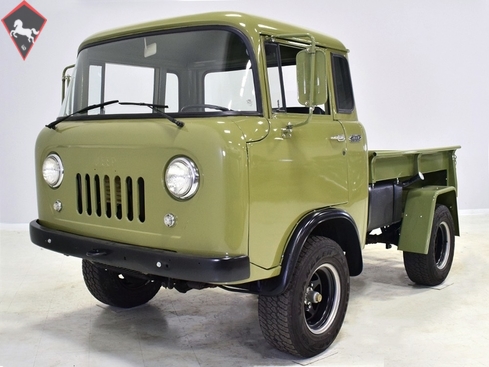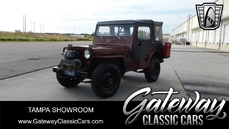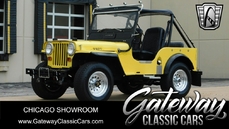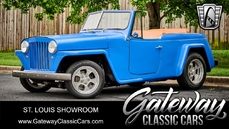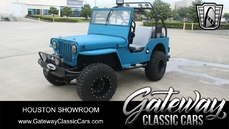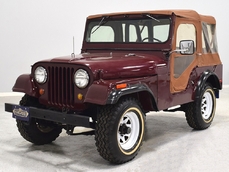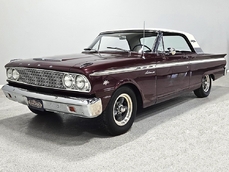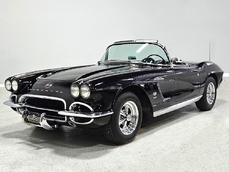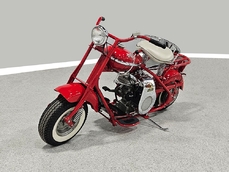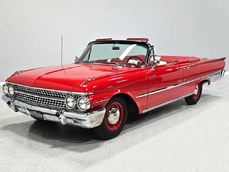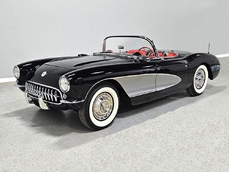Willys Jeep 134 cubic inch inline-4 1961
Allmän beskrivning :
In the 1950s, automakers were still willing to color outside the lines, and few were more daring than the Willys Corporation. Existing on the edge of the industry with a lineup of military and commercial vehicles, plus variations adapted for consumer use, they were innovative in a way we can’t really imagine today. Designed by noted industrial designer Brooks Stevens, the Forward Control trucks were intended to deliver full-sized practicality in a much more maneuverable package and in that regard they were a huge success. Trucks like this 1961 Willys Jeep FC150 could carry as much as a full-sized ½-ton pickup but had a footprint barely larger than a 2-seat Nash Metropolitan. Yeah, no kidding! Combined with rugged mechanicals, go-anywhere 4-wheel-drive, and distinctive Jeep looks, it was a clever idea that never quite caught on. Aside from duty in the parks service and on ranches out west, the extreme cab-forward seating position never really caught on with consumers. Only about 30,000 were built during nine years of production, making them a real rarity today.
This handsome late-production FC150 pickup is the smaller of the two variations (with the other being the FC170) and it is the more popular version with today’s enthusiasts. It’s sized right to be a lot of fun and since it was loosely based on the CJ5, it has the same go-anywhere ruggedness you’ve come to expect from Jeep. It features a high-quality restoration of a fairly solid truck (restoration photos show only the lower doors needed work) and it’s 100% ready to enjoy today. It’s worth noting that the entire bed was re-created from scratch using a few of the original support braces to make it look right and it has never done a day of work since completion. The olive green finish is certainly appropriate on the cheerful little truck, although most were bright red, and we’re tempted to stick a big white star on its doors to complete the look. Finish quality is surely better than new, although not perfect—that wasn’t the goal and making it perfect would remove your temptation to get it dirty. New fenders were fabricated and mounted a little lower on the box just to make it look right and putting them back to the stock position requires nothing more than a pair of wrenches, although we suspect you won’t bother. The tailgate includes correct badging as well as two simple taillights above a bumper so crude that it makes you smile.
Inside, it’s definitely bare-bones. Twin bucket seats are perched atop the fender wells and wrapped in textured black vinyl that helps keep you cool on warm days. The door panels were upholstered to match, which is a nice touch, and this truck is fully optioned: heater and turn signals. If you’ve driven a city bus or a VW van, the driving position will feel familiar, although it does require a little acclimation to realize you’re sitting on top of the front wheels, and as a result it is extremely maneuverable. The big wheel makes it relatively easy to handle, although you want to keep it rolling a little bit to reduce effort. Controls are limited to the shifters in the center for the 3-speed manual transmission and transfer case, a few knobs for headlights and wipers (now electric instead of vacuum), plus a switch for the big electric fan up front that is designed to help keep it cool in parades. You also get a mammoth Willys heater on the firewall and it’s probably potent enough to roast a Thanksgiving turkey. The factory gauges covered the basics, and someone has added a set of vintage Stewart-Warner dials under the dash and they look appropriate (for some reason the fuel gauge reads in reverse—keep that in mind!). The doghouse between the seats houses the sturdy little Jeep 4-cylinder engine, with a flip-up door for easy access to the vital things like oil and coolant fillers and the dipstick. It’s definitely minimalist, but it’s also quite nicely done.
For power, it uses Willys’ rugged 134 cubic inch F-head inline-4. For those of you unfamiliar with this engine or an “F-head” configuration, it uses overhead valves for the intake side and valves in the block flathead-style for the exhaust. Surely they had their reasons for doing it that way, and we can’t argue with the way it works. It makes gruff, no-nonsense noises and it’s torquey enough to work with the rather short gears in the differentials to make it feel peppy around town and off road. It’s also bulletproof reliable, fully rebuilt, and completely stock, so it works like it should. It starts easily with a little choke, and if you’ve got the time this little truck will take you anywhere you want to go. Thanks to the aforementioned electric fan working in conjunction with the engine-driven fan, it stays nice and cool and there are custom vents on the back of the cab to help exhaust engine heat to control temperatures in the cabin. It works better than you’d expect and will outlast us all!
The T90 3-speed manual transmission should feel familiar to Jeep fans, and it’s connected to a Spicer 18 transfer case, which feeds power to the Spicer 25 front axle and Dana 44 rear axle. Gears are 5.38s, so it wasn’t built for speed, but it will cruise happily at 45-50 MPH and in low range it can climb a wall at little more than idle speed. If you’re brave enough to take it off-roading, you’ll quickly discover that this little truck can do things you couldn’t imagine in today’s giant 4x4s. There are skid plates protecting the vitals, a new exhaust system, new shocks, and a freshly restored gas tank hanging on the side. In addition, the brakes have all been rebuilt and it stops rather well given its modest performance, and yes, it does still have that 250-pound chunk of cast iron hanging under the rear tailgate designed to keep it from planting itself on its nose (whether it is necessary is debatable, but the government made them install it). The wheels and tires are modern, including the somewhat oversized 235/75/15 Goodyear Wrangler radials, but they look great and really do improve the ride. The spare is an NOS 6.70-15 Goodyear bias-ply on an original wheel, just because it looks right there in the tire well on the side.
This neat little truck brings a smile to everyone’s face when they see it and its eager personality and funky driving style make it unique among almost everything else you’ll ever drive. Jeep recently built a show vehicle based on the Forward Control and it was a major hit, and we’ve found that this modestly-priced 4x4 will be the star of almost any show it attends. Add in the fact that it’s still practical and you’ll always have the only one at any event, and you end up with something special. Hard to imagine having more fun than this in an old vehicle. Call today!
http://www.harwoodmotors.com/vehicles/inventory_details.php?id=1056
1961 Willys Jeep 134 cubic inch inline-4 is listed såld on ClassicDigest in Macedonia by for Ej prissatt.
Fakta i bilen
Karosstyp : Personbil Märke : Willys Modell : Jeep Modellversion : 134 cubic inch inline-4 Motorvolym : 0.0 Årsmodell : 1961 Karosstyp : Pick up Läge : Ohio
Såld
Information om säljaren
Såld
People who viewed this Willys Jeep also viewed similar Willys listed at ClassicDigest
Other cars listed for sale by this dealer
om Willys
Willys-Overland Company, senare känd som Willys, var en amerikansk biltillverkare som spelade en betydande roll i bilhistorien. Här är en översikt över historien om Willys:Tidiga år:
Grundande: Företaget grundades av John North Willys 1908 i Toledo, Ohio, ursprungligen som Willys-Overland Motor Company. John Willys förvärvade Overland Automotive Division of Standard Wheel Company, som tillverkade Overland-bilen.
Tidig framgång: Willys-Overland upplevde framgång i början av 1910-talet och tillverkade fordon som Overland Model 79, som var en populär bil på grund av dess prisvärdhet och tillförlitlighet.
Första världskriget:
Militära kontrakt: Under första världskriget säkrade Willys-Overland betydande kontrakt för att leverera fordon för krigsinsatsen. Företagets produktionskapacitet var avgörande för militären och tillverkade lastbilar och bilar för olika ändamål.
Introduktion av jeepen:
Bidrag från andra världskriget: Under uppbyggnaden till andra världskriget svarade Willys-Overland, tillsammans med andra biltillverkare, på den amerikanska arméns begäran om ett lätt, terrängspaningsfordon. Företaget utvecklade Willys MB, som blev den ikoniska Jeep.
Jeep Legacy: Jeepen, med sin robusthet, mångsidighet och tillförlitlighet, spelade en avgörande roll under andra världskriget. Dess framgång ledde till etableringen av Jeep-märket, känt för att tillverka terrängfordon som vunnit popularitet i både militära och civila tillämpningar.
Efterkrigstiden:
Civila Jeep-modeller: Efter kriget introducerade Willys civila versioner av Jeep, som CJ-serien (Civilian Jeep), som anpassades från krigstidens Willys MB. Dessa fordon blev populära för terräng- och fritidsbruk.
Willys evolution och senare år:
Ägarförändringar: Willys-Overland stod inför ekonomiska svårigheter och bytte ägare flera gånger under efterkrigsåren, och blev så småningom Kaiser-Jeep Corporation efter att ha förvärvats av Kaiser Motors på 1950-talet.
Slutet på Willys: 1970 förvärvade American Motors Corporation (AMC) Kaiser-Jeep. Willys namnskylt försvann gradvis när AMC fokuserade på Jeep-märket. Senare förvärvade Chrysler AMC på 1980-talet och fortsatte produktionen och utvecklingen av jeepfordon.
Arv:
Willys arv är främst förknippat med dess bidrag till bilindustrin genom skapandet av Jeep, ett fordon som förändrade mobiliteten under andra världskriget och blev ett ikoniskt varumärke i sig. Jeepens rykte för hållbarhet, mångsidighet och terrängförmåga har sitt ursprung i Willys-Overlands innovationer och framgångar under krigstid.
